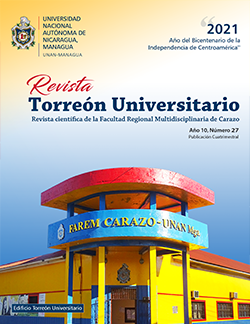Lipolytic activity of fungi isolated from used cooking oil and machine shop floors
DOI:
https://doi.org/10.5377/torreon.v10i27.10845Keywords:
Lipolytic fungi, lipase, enzyme activity, used cooking oilAbstract
The objective of the research was to select the genus with the highest enzymatic activity by using used cooking oil as the only source of the substrate. Fungi were isolated from used cooking oil and from contaminated soils by mechanical car repair shops. The samples were inoculated in general fungal media (PDA agar), when obtaining axenic cultures they were inoculated in selective agar for lipolytic fungi (tributyrin agar), the genus were identified by bright field microscopy and phase contrast. In the selective medium, the presence of halo around the colony or crystallization close to the colony was considered as an indicator of lipolytic genus. The genus identified in soil were Fusarium and Aspergillus, the genus Aspergillus was identified in the oil. The tests were carried out with aeration, without aeration, in the tests without aeration, the interaction between the genuses isolated from the soil was evaluated, which was named consortium. The enzymatic activity in the first phase for the genus Aspergillus in tests without aeration, isolated from the oil was 0.0148 (U / ml). For Aspergillus and Fusarium isolated from the soil, the enzymatic activity was 0.0051 and 0.0055 (U / ml) respectively; in the consortium it was 0.003 U / ml. The genus Aspergillus isolated from the oil showed higher enzymatic activity and was selected for the second phase of lipolytic activity measurement. The highest enzymatic activity 0.0777 (U / ml) was obtained at 144 hours, when the culture was evaluated with aeration interrupted and continuous feeding. When the cultures were subjected to an aeration interrupted and discontinuous feeding, the enzymatic activity was similar to that achieved without aeration (0.026 and 0.034 (U / ml) respectively). These results suggest that the genus studied are capable of utilize used cooking oil as the only carbon source for their metabolic processes.
Downloads
Downloads
Published
How to Cite
Issue
Section
License
The authors who publish in this journal agree to the following terms.
- The author or authors of the articles, essays or research grant the National Autonomous University of Nicaragua, Managua (UNAN-Managua) the editing rights (copyright) of the submitted work, therefore the University has the exclusive right to publish the article for the entire copyright period.
- These copyrights/authors authorize Torreón Universitario Magazine and the University to edit and disseminate/publish the article in said Magazine, including printed and electronic reproduction, storage, retrieval and any other type of publication, and sources of secondary information as services. of summaries and databases, they also empower it to protect the article against unauthorized use for dissemination by printed or electronic media (PDF, HTML, EPUB, XML or others).
License for use of content
The magazine uses the Creative Commons Attribution-NonCommercial-NoDerivs 4.0 International License.
Under this statement:

This journal is licensed under a Creative Commons Attribution-NonCommercial-NoDerivatives 4.0 International License. It can be copied, distributed and transmitted publicly as long as the author and source are cited (Revista Torreón Universitario), it should not be modified or used for any commercial purpose. The full license can be found at http://creativecommons.org/licenses/by-nc-nd/4.0/.



